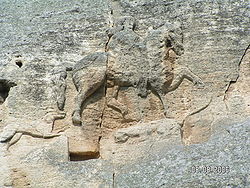Madara rider
| Madara rider | |
|---|---|
|
UNESCO world heritage |
|

|
|
| Rock relief of the rider of Madara |
|
| National territory: |
|
| Type: | Culture |
| Criteria : | (i) (iii) |
| Surface: | 1.2 ha |
| Buffer zone: | 501.7 ha |
| Reference No .: | 43 |
| UNESCO region : | Europe and North America |
| History of enrollment | |
| Enrollment: | 1979 ( session 3 ) |
The rider of Madara is an early medieval monumental rock relief located on the Madara rock plateau near the village of Madara in northeastern Bulgaria, not far from the former Bulgarian capital Pliska . The relief was part of the main cult site of the First Bulgarian Empire and is located on a sandstone cliff about 100 meters high. It shows a rider at a height of 23 meters above the ground. The rider is shown with a lion at his feet, which he has just killed. He is accompanied by a dog.
The bas-relief is generally attributed to the Proto- Bulgarians who settled in this area and dates to the beginning of the 8th century. Other theories speak of a Thracian origin.
The monument has been a World Heritage Site since 1979 .
Inscriptions
On both sides of the relief, three fragments of Middle Greek inscriptions were found, which were identified as the inscription Ι (a, b, c and d), inscription II (a and b) and inscription III. In them khans report on their campaigns against the Byzantine Empire .
The inscription "I c" was found by Vesselin Beschevliev . In this inscription Khan Terwel describes his relations with the Byzantine emperors and with his relatives (uncles) who are settled near Thessaloniki. This is Terwel's uncle, Khan Kuver :
- [...] the Bulgarians [...] and came to Terwel . My uncles in the region around Thessaloniki did not believe the emperor with the cut off nose and went back to Kisinas [...] one of his [...] by treaty the ruler Terwel gave the emperor [...] five thousand [. ..] the emperor won well with me.
Trivia
In a vote by Bulgarian television in June 2008, the Madara rider prevailed against other national symbols as the future symbol of the Bulgarian euro coin. The timing of the introduction of the common currency is still unclear.
literature
- Velina Koleva Dimitrova: Evidence of the art and culture of the Proto- Bulgarians from the pagan period of the First Bulgarian Empire (7th-9th centuries). Dissertation, FU Berlin 2007, pp. 178-229 ( full text ).
Web links
Individual evidence
- ^ Vesselin Beschevliev: The proto-Bulgarian inscriptions. Bulgarian Academy of Sciences, Sofia 1979, p. 94.
- ↑ Original text is in ancient Greek
- ↑ Discussion about the future Bulgarian euro coins ( Memento of the original from November 13, 2013 in the Internet Archive ) Info: The archive link was inserted automatically and has not yet been checked. Please check the original and archive link according to the instructions and then remove this notice. , accessed November 13, 2013
Coordinates: 43 ° 16 ′ 39.2 ″ N , 27 ° 7 ′ 7.4 ″ E

